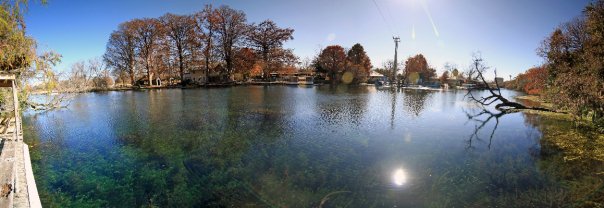At the feeding place this morning, a Black-Bellied-whistling duck, three American Coots, several Green Herons, and a Gadwall were present. After the Black-Bellied-whistling duck finished its breakfast, the bird waded into a deeper area. The bird started scooping up and splashing the water as if taking a bath, grooming itself carefully, and then flew away toward the river.
Seven divers drove into Spring Lake with air tanks. I saw twice as many air tanks lined up in the diver preparation area next to the Landing, and I thought that they were aiming to dive deep this morning.
On the lawn in front of the diving facility, I saw the young Yellow-Crowned-Night Heron facing two juvenile Yellow-Crowned-Night Herons. I thought that one of juveniles was the offspring of the young Yellow-Crowned-Night Heron. They stood still for a while. Then, the young Yellow-Crowned-Night Heron turned around and walked to the barrier to hunt. I thought that she was hungry. The other two juvenile herons were hungry, too. One of the young herons hurried to the barrier to start hunting, and the other followed. Immediately, the young Yellow-Crowned-Night Heron spread her wings and shooed both juvenile herons away. After repeatedly refusing to hunt crayfish together on the barrier, the two young, juvenile herons flew away together toward the river.
The excavation site beside the Aquarena Center Office was enclosed by mesh wire fence, but the excavation members were not present this morning. The digging site was covered by a tarp, and a large wooden plate was on top of it.
Yesterday afternoon, I stopped by the Aquarena Center for a short time to see the progress of the excavation by the members of the Center for Archaeological Studies at Texas State University. At that time, a staff member who was working in the four-foot wide square site had found a tiny black object in the soil that he had just dug up, and picked it up with the tip of an archaeology trowel. He said that it was charcoal. The measurement of its depth was nearly 60 centimeters. During another dig, he had come across a piece of chert. Other staff members who were shifting the soil with large shifters found small, round snails. The number of snails found today was more than yesterday, and that’s a indicator of the weather patterns during that time period.
Beyond 60 centimeters depth, the some soil appeared to be a lighter color than some rocks found from the upper soil. I thought that the lighter color material was clay. He corrected me; it was clay loam, and indicates that there was a flood during that period that brought in some materials from other areas. From studying artifacts and soil conditions, members of the Center for Archaeological Studies are exploring Spring Lake’s past by using their knowledge, experiences, imaginations, and passion. This excavation is an incredibly exciting project!
